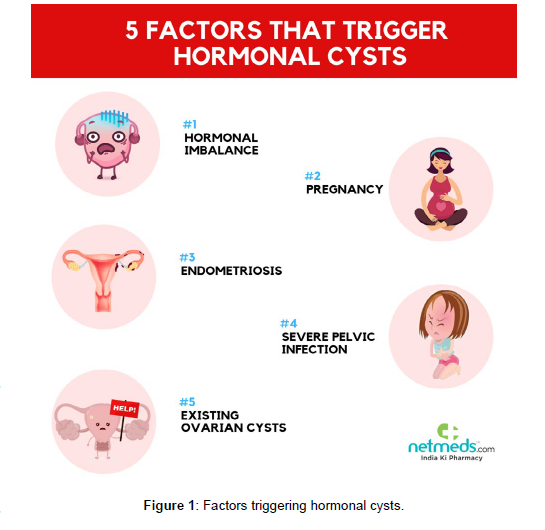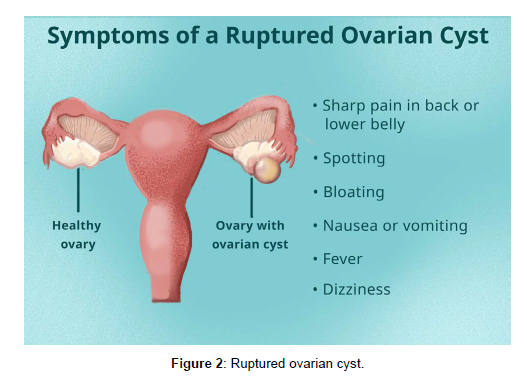Understanding Ovarian Cysts: Causes, Symptoms, and Treatment
Received: 03-Aug-2023 / Manuscript No. JCPHN-23-110433 / Editor assigned: 05-Aug-2023 / PreQC No. JCPHN-23-110433 (PQ) / Reviewed: 19-Aug-2023 / QC No. JCPHN-23-110433 / Revised: 22-Aug-2023 / Manuscript No. JCPHN-23-110433 (R) / Published Date: 29-Aug-2023 DOI: 10.4172/2471-9846.1000446
Abstract
Ovarian cysts are a common gynaecological condition that affects many women at some point in their lives. These fluid-filled sacs can develop on or within the ovaries, often causing a range of symptoms and raising questions about their nature, causes, and appropriate management. In this article, we will delve into the world of ovarian cysts, exploring their causes, symptoms, and available treatment options.
Keywords
Ovarian cysts; Hormonal imbalances; Menstrual irregularities; Endometriosis
Introduction
Ovarian cysts are small, fluid-filled sacs that form on or within the ovaries – the two small, almond-shaped organs located on either side of the uterus. While most ovarian cysts are benign and resolve on their own, some can cause discomfort and complications. Ovarian cysts are categorized into two main types: functional cysts and pathological cysts [1].
Methodology
Types of ovarian cysts
Functional cysts: These cysts are the most common and generally form during the menstrual cycle. They include follicular cysts, which develop when a follicle fails to release an egg, and corpus luteum cysts, which can occur if the corpus luteum (the structure that forms after the egg is released) persists and fills with fluid.
Pathological cysts: These cysts are less common and can be more concerning. They include dermoid cysts (composed of tissues like hair and skin), endometriomas (cysts resulting from endometriosis), and cystadenomas (cysts that develop from ovarian tissue).
Causes and risk factors
The precise causes of ovarian cysts are not always clear, but several factors can contribute to their development:
Hormonal imbalances: Fluctuations in hormone levels, particularly estrogen and progesterone, can lead to the formation of cysts [2, 3].
Menstrual irregularities: Conditions that affect ovulation or disrupt the normal menstrual cycle can increase the risk of cyst development.
Pregnancy: Cysts can form during early pregnancy as a result of hormonal changes.
Endometriosis: This condition involves the growth of uterine tissue outside the uterus and can lead to the formation of cysts.
Polycystic ovary syndrome (PCOS): Women with PCOS are more prone to developing multiple cysts due to hormonal imbalances [4, 5]. (Figure 1)
Symptoms
Ovarian cysts can present with a range of symptoms, which may vary in intensity and duration. Common symptoms include:
Pelvic pain: Dull or sharp pain in the lower abdomen or pelvis is a common symptom, particularly if a cyst ruptures or causes the ovary to twist (ovarian torsion).
Bloating and pressure: Cysts can cause a feeling of bloating or fullness in the abdomen, often leading to discomfort [6].
Changes in Menstrual Cycle: Irregular periods or changes in menstrual flow may occur.
Painful intercourse: Some women may experience pain during sexual intercourse.
Urinary or digestive symptoms: Large cysts can press against the bladder or rectum, leading to frequent urination or changes in bowel habits.
(Figure 2)
Diagnosis and treatment
Ovarian cysts are often discovered during routine pelvic examinations or imaging studies. If a cyst is suspected, additional tests such as ultrasounds or MRI scans may be performed to assess its size, appearance, and characteristics.
Treatment for ovarian cysts depends on various factors, including the type of cyst, its size, and the presence of symptoms. Options include:
Watchful waiting: Functional cysts often resolve on their own within a few menstrual cycles and may not require immediate intervention.
Medication: Hormonal birth control pills can help regulate hormone levels and prevent the development of new cysts.
Surgical removal: Larger or persistent cysts may require surgical removal, which can be done through minimally invasive laparoscopic surgery.
Management of underlying conditions: Treating conditions like PCOS or endometriosis can help prevent future cyst formation [7-9].
Ovarian cysts are a common occurrence in women's reproductive health. While most cysts are harmless and resolve on their own, it is important to be aware of potential symptoms and seek medical attention if necessary. Regular gynaecological check-ups and open communication with healthcare providers can help monitor and manage ovarian cysts, ensuring the best possible reproductive and overall well-being [10, 11].
Results
In the intricate landscape of women's reproductive health, ovarian cysts emerge as both a common occurrence and a potential source of concern. Through our exploration, we have delved into the causes, types, symptoms, diagnosis, and management of these fluid-filled sacs that find their home within the ovaries.
Ovarian cysts, often benign and temporary, are a testament to the intricate interplay of hormones and biological processes that characterize a woman's menstrual cycle. From functional cysts that ebb and flow with the rhythm of ovulation to more complex pathological cysts that demand attention, understanding the underlying mechanisms empowers individuals to grasp the dynamics of their own bodies.
Symptomatology, an essential compass in healthcare, guides us toward recognizing the presence of ovarian cysts. The spectrum of experiences, from pelvic pain and bloating to changes in menstrual patterns, acts as a signal, urging us to seek professional evaluation and intervention when needed. The vigilant collaboration between healthcare providers and patients ensures a timely diagnosis, allowing for informed decisions regarding treatment and management options. (Table 1)
| Aspect | Description |
|---|---|
| Definition | Fluid-filled sacs within or on the surface of the ovaries. |
| Types | Functional (follicular, corpus luteum) and non-functional (dermoid, endometrioma). |
| Causes | Hormonal imbalances, ovulation issues, endometriosis, polycystic ovary syndrome (PCOS). |
| Symptoms | Pelvic pain, bloating, irregular periods, pain during intercourse, urinary issues. |
| Diagnosis | Physical exam, ultrasound, MRI, CT scan, blood tests (CA-125), laparoscopy. |
| Management | Observation, pain relief (NSAIDs), hormonal birth control, surgery (if necessary). |
| Complications | Rupture, torsion, ovarian cancer (rare), infertility (in severe cases). |
| Pregnancy | Ovarian cysts during pregnancy are common; most resolve on their own. |
| Follow-up | Regular monitoring for changes in size, symptoms, or complications. |
| Surgical Options | Laparoscopic cystectomy, oophorectomy, cyst aspiration, laparotomy (rarely). |
| Lifestyle Considerations | Weight management, hormonal balance, regular exercise, stress reduction. |
| Patient Education | Explain cyst type, management options, signs of complications, and when to seek care. |
| Emotional Support | Address patient concerns, provide reassurance, offer coping strategies. |
| Prevention | Not always preventable; maintaining overall health and hormone balance can help. |
| Healthcare Provider Collaboration | Coordinate care with gynecologists, surgeons, and specialists as needed. |
| Public Awareness | Educate about symptoms, risk factors, and the importance of seeking medical attention. |
Table 1:Key points on ovarian cyst.
Discussion
The vigilant collaboration between healthcare providers and patients ensures a timely diagnosis, allowing for informed decisions regarding treatment and management options. The diagnostic journey, encompassing physical examinations, advanced imaging techniques, and biochemical markers, weaves together a comprehensive narrative that aids in deciphering the intricacies of ovarian cysts. Armed with this knowledge, medical practitioners can guide patients toward tailored strategies, encompassing watchful waiting, pharmacological interventions, or surgical procedures
Ovarian cysts are fluid-filled sacs that can develop within the ovaries, which are crucial components of the female reproductive system. While most ovarian cysts are benign and resolve without causing significant issues, they can occasionally lead to discomfort, pain, or complications. Understanding the intricacies of ovarian cysts, including their causes, symptoms, diagnosis, and management, is vital for informed decision-making and proper healthcare. (Table 1)
Conclusion
The vigilant collaboration between healthcare providers and patients ensures a timely diagnosis, allowing for informed decisions regarding treatment and management options. The diagnostic journey, encompassing physical examinations, advanced imaging techniques, and biochemical markers, weaves together a comprehensive narrative that aids in deciphering the intricacies of ovarian cysts. Armed with this knowledge, medical practitioners can guide patients toward tailored strategies, encompassing watchful waiting, pharmacological interventions, or surgical procedures.
As we conclude this discourse, a resounding truth emerges: informed awareness is a powerful shield against the uncertainties of health. By fostering dialogue, cultivating understanding, and embracing a proactive approach to reproductive well-being, women can traverse the terrain of ovarian cysts with confidence. Regular health check-ups, open communication, and a commitment to self-care become the cornerstones upon which a robust foundation of well-being is built.
In the grand tapestry of women's health, ovarian cysts are but one thread, a thread that serves as a reminder of the intricate orchestration of the human body. As we continue to unravel the mysteries of our own physiology, let us celebrate the resilience of the human spirit and the boundless potential of knowledge in illuminating the path to a healthier, more empowered future.
References
- Rim D, Wallace LA, Nabinger S, Persily A (2012) Reduction of exposure to ultrafine particles by kitchen exhaust hoods: The effects of exhaust flow rates, particle size, and burner position. Sci Total Environ. 432: 350-56.
- Singer BC, Pass RZ, Delp WW, Lorenzetti DM, Maddalena RL (2017) Pollutant concentrations and emission rates from natural gas cooking burners without and with range hood exhaust in nine California homes. Build Environ. 43:3235–42.
- WHO (2005) Air Quality Guidelines - Global update 2005.
- Kim H, Kang K, Kim T (2018) Measurement of particulate matter (PM2.5) and health risk assessment of cooking-generated particles in the kitchen and living rooms of apartment houses. Sustainability 10: 843.
- Liu Q, Son YJ, Li L, Wood N, Senerat AM, et al. (2022) Healthy home interventions: Distribution of PM2.5 emitted during cooking in residential settings. Build Environ 207: 108448.
- O’Leary C, Jones B, Hall I (2018) An intervention study of PM2.5 concentrations measured in domestic kitchens. AIVC 2018: Smart Ventilation for Buildings. At: Antibes Juan-les-Pins, France.
- O’Leary C, De Kluizenaar Y, Jacobs P, Borsboom W, Hall I, et al. (2019) Investigating measurements of fine particle (PM2.5) emissions from the cooking of meals and mitigating exposure using a cooker hood. Indoor Air 29(3): 423-438.
- Jacobs P, Cornelissen E (2017) Efficiency of recirculation hoods with regard to PM2.5 and NO2. Healthy Buildings 2017 Europe. At: Lublin, Poland.
- He C, Morawska L, Hitchins J, Gilbert D (2004) Contribution from indoor sources to particle number and massconcentrations in residential houses. Atmos Environ 38(21): 3405-3415.
- Dobbin NA, Sun L, Wallace L, Kulka R, You H, et al. (2018) The benefit of kitchen exhaust fan use after cooking - An experimental assessment. Build Environ 135: 286-296.
- Goldberg M, Burnett R, Bailar J, Brook J, Bonvalot Y, et al. (2001) The association between daily mortality and ambient air particle pollution in Montreal, Quebec 1. Nonaccidental mortality. Environ Res 86: 12–25.
Indexed at, Google Scholar, Crossref
Indexed at, Google Scholar, Crossref
Indexed at, Google Scholar, Crossref
Citation: Edwards L (2023) Understanding Ovarian Cysts: Causes, Symptoms,and Treatment. J Comm Pub Health Nursing, 9: 446. DOI: 10.4172/2471-9846.1000446
Copyright: © 2023 Edwards L. This is an open-access article distributed underthe terms of the Creative Commons Attribution License, which permits unrestricteduse, distribution, and reproduction in any medium, provided the original author andsource are credited.
Select your language of interest to view the total content in your interested language
Share This Article
Recommended Journals
Open Access Journals
Article Tools
Article Usage
- Total views: 1424
- [From(publication date): 0-2023 - Sep 23, 2025]
- Breakdown by view type
- HTML page views: 1095
- PDF downloads: 329


